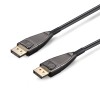What is an Active Optical Cable?

An Active Optical Cable (AOC) is a type of cable that integrates active components, such as lasers and photodiodes, directly into the cable assembly. It combines optical fibers with electronic components to enable high-speed data transmission over longer distances.
Unlike traditional optical cables that rely on separate transceivers at each end for signal conversion, AOCs have the optical transceiver modules built directly into the cable connectors. These transceiver modules convert electrical signals into optical signals for transmission through the optical fibers, and then back to electrical signals at the receiving end.
AOCs are commonly used in applications that require high-speed data transfer and low latency, such as data centers, high-performance computing, telecommunications, and audiovisual connectivity. They support various protocols, including Ethernet, InfiniBand, HDMI, USB, DisplayPort, and Thunderbolt, allowing for the transmission of high-bandwidth signals.
Some key advantages of Active Optical Cables include:
Longer Reach: AOCs can transmit data over longer distances compared to copper cables, while maintaining signal integrity and minimizing signal loss.
High Speed: AOCs support high-speed data transmission rates, typically ranging from 10Gbps to 400Gbps and beyond, depending on the specific cable specifications.
Low Latency: AOCs offer low latency, making them suitable for applications that require real-time data transfer, such as gaming and video streaming.
Lighter and Thinner: AOCs are typically lighter and thinner compared to traditional copper cables, which can make them easier to handle and route in tight spaces.
EMI/RFI Immunity: Optical signals transmitted through AOCs are not susceptible to electromagnetic interference (EMI) or radio frequency interference (RFI), ensuring better signal quality and stability.
It's worth noting that AOCs are designed for specific applications and may have different connector types (such as SFP, QSFP, or MPO) depending on the intended use.







